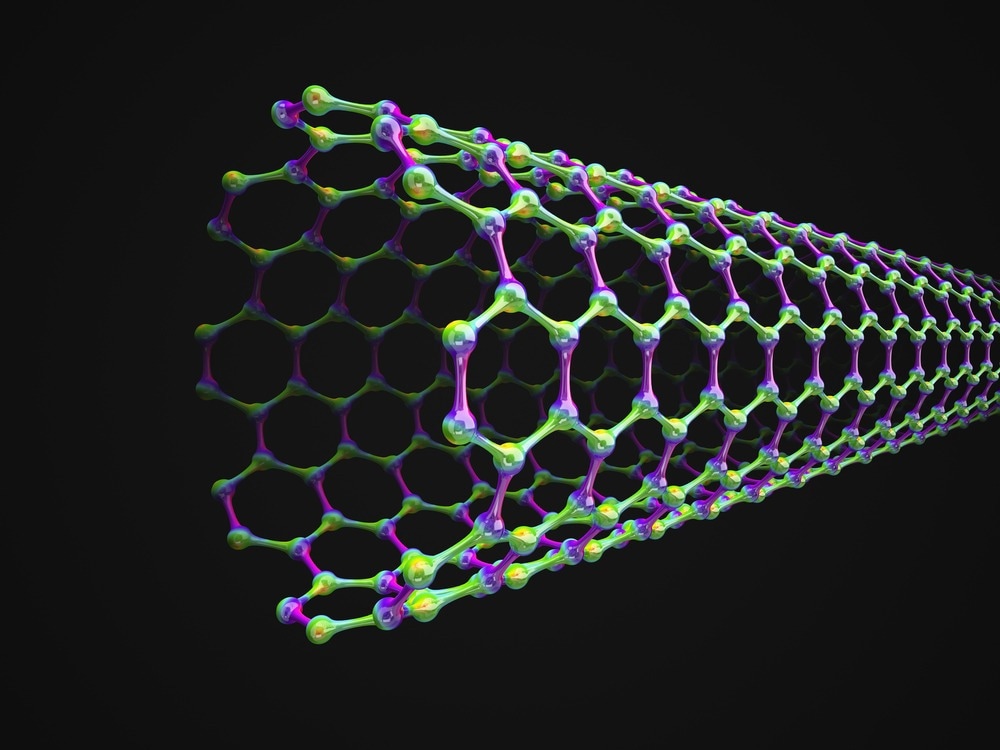Carbon nanotubes, commonly abbreviated as CNTs, are tubular nanostructures composed of a distinctive carbon allotrope arranged in a hexagonal lattice reminiscent of graphite sheets. The rolling of a single wall results in the formation of single-walled carbon nanotubes (SWCNTs), whereas the multi-walled carbon nanotubes (MWCNTs) are identified by the presence of multiple concentric walls arranged concentrically within the nanotube structure.

Image Credit: Orange Deer studio/Shutterstock.com
What sets CNTs apart is the concept of chirality. The production of CNTs can follow either a chirality-controlled or a non-chirality-controlled process, such as armchair, zigzag, or chiral. For armchair CNTs, the circumferential vector (C) aligns precisely between the two basis vectors, resulting in a chiral angle (θ) of 30 degrees when n equals m. Zigzag CNTs have the circumferential vector aligned purely along one of the basis vectors, leading to a chiral angle of 0 degrees where one of the chiral indices, n or m, is zero. Chiral CNTs are formed when m ≠ n, and the chiral angle falls within the range of 0 to 30 degrees.
Researchers make many efforts to separate out single chirality CNTs to take advantage of the inherent high performance of CNTs. Gel chromatography is widely used for large-scale chirality separation. The effects of surfactant concentration and temperature play significant roles in this process.
Recently, Prof Liu and his team from the Institute of Physics, Chinese Academy of Science, reported a large-scale industrial separation method. This method isolates single chirality CNTs from various raw materials using gel chromatography with a high-concentration solution of HiPco-SWCNTs. This technique reduces the cost of producing single chirality CNTs while minimizing environmental impact, increasing the separation yield by nearly six times to reach milligram scale.
Chirality-Dependent Properties
The chirality of CNTs profoundly influences their electronic, mechanical, and optical properties, unlocking potential for specific applications. Chirality alters the bandgap, affecting electrical and optical properties. For chiral indices n and m, and integer k, if n-m=3k, the CNTs exhibit metallic conductivity; if n-m=3k+1 or 2, they behave as semiconductors.
Prof Liu's team examined how chiral SWCNTs influence electrical conductivity. They evaluated the functionality of thin-film transistors made from eleven different (n, m) single-chirality SWCNT films. They found that SWCNTs with distinct chiral angles but the same diameter exhibit significant variations in on-state current and carrier mobility. This disparity is due to differences in their electronic band structures, affecting the contact barrier between electrodes and SWCNTs, as well as intrinsic and contact resistance.
CNT-based sensors have applications ranging from environmental monitoring to critical medical diagnostics. During the COVID-19 pandemic, the need for better, more cost-effective biomaterial detection methods became apparent. Farah Marsusi from Amirkabir University investigated the response of CNTs and Carbon nanobelts to N-linked and O-linked SARS-CoV-2 spike glycoproteins. Chiral semiconductor CNTs showed a response to the glycoproteins, evidenced by changes in electronic band gap and density of state.
Photonic applications capitalize on the photoluminescent attributes of chirality-specific CNTs, dependent on the precise carbon-atom honeycomb arrangement. In semiconducting CNTs, excited states can generate 1D excitons with dissociation energies around 0.5 eV. Engineering nanotubes with specific chiralities enables the creation of photodetectors and solar cells with improved efficiency.
Prof Alexey N. Volkov from the University of Alabama theoretically investigated the impact of CNT chirality on mechanical properties. They demonstrated the effect of CNT diameter on deformation mechanisms. The mechanical properties, including the strength and shear modulus of CNTs, are inversely proportional to their diameter. Films of (5,5) chirality CNTs withstand large strain compression without irreversible structural changes.
The strong sigma bonds between carbon atoms in CNTs endow them with an exceptionally high Young's modulus and tensile strength. This structural resilience allows CNTs to bend without breaking, enhancing their mechanical robustness. Such mechanical properties are useful in developing composite materials, coatings, and nanomechanical systems.
Final Remarks and Market Overview
The market for chirality-specific CNTs is experiencing substantial growth, driven by their diverse applications. From optimizing electronic components and propelling advancements in photonics and optoelectronics to fortifying materials for mechanical applications, chirality-specific CCNTs emerge as pivotal players. CNTs have the versatility to replace various components of solar cells, including light-sensitive elements, carrier selective contacts, passivation layers, transparent conducting films, and mechanical coatings and composites.
While the yield and purity of single chiral CNT species have improved, the high cost of pure chiral CNTs remains a challenge. With ongoing research and technological innovation, CNTs are poised to become integral components in cutting-edge applications, revolutionizing industries and opening up new possibilities for advanced materials and systems.
References and Further Reading
Yang, Dehua, et al. (2023) Preparing high-concentration individualized carbon nanotubes for industrial separation of multiple single-chirality species. Nature Communications 14.1, 2491. https://doi.org/10.1038/s41467-023-38133-0
Peng, Lean Mao et al. (2019) Carbon nanotube digital electronics. Nat Electron 2, 499–505 https://doi.org/10.1038/s41928-019-0330-2
Su, Wei, et al. (2023) Chirality-dependent electrical transport properties of carbon nanotubes obtained by experimental measurement. Nature Communications 14.1,1672. https://doi.org/10.1038/s41467-023-37443-7
Monavari, Seyyed Mostafa, et al. (2023) Carbon nanotubes and nanobelts as potential materials for biosensor. Scientific Reports 13.1, 3118. https://doi.org/10.1038/s41598-023-29862-9
Kayang, Kevin W et al. (2022) Chirality-dependent mechanical properties of bundles and thin films composed of covalently cross-linked carbon nanotubes. Langmuir 38.6 1977-1994. https://doi.org/10.1021/acs.langmuir.1c02632
Avouris, Phaedon et al. (2008) Freitag, M. & Perebeinos, V. Carbon-nanotube photonics and optoelectronics. Nature Photon 2, 341–350 https://doi.org/10.1038/nphoton.2008.94
Rojas William A Gaviria et al. (2020) Chirality‐enriched carbon nanotubes for next‐generation computing." Advanced Materials 32.41, 1905654. https://doi.org/10.1002/adma.201905654
Disclaimer: The views expressed here are those of the author expressed in their private capacity and do not necessarily represent the views of AZoM.com Limited T/A AZoNetwork the owner and operator of this website. This disclaimer forms part of the Terms and conditions of use of this website.